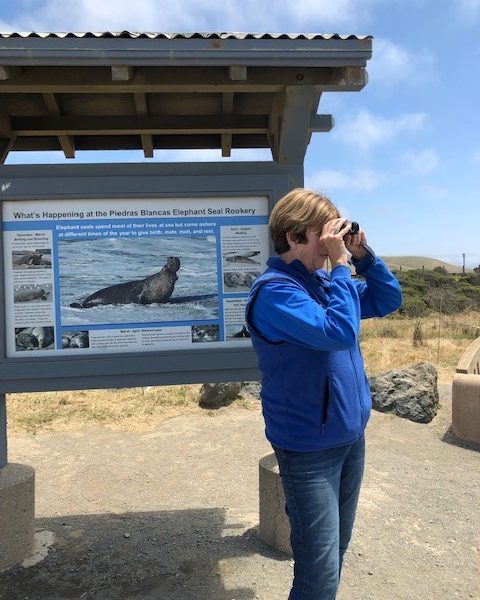
Volunteer Docent, Class of 2015
Q: How did you become interested in serving as a docent for the Friends of the Elephant Seal? How long have you been a docent?
A: I became interested in elephant seals while a marine biology major at San Diego State University in the 1970’s. At that time, there were no recorded populations of elephant seals along the California coastline. But our professor, Dennis Bostic and a colleague, Dr. Ray Gilmore at the San Diego Natural History Museum, had discovered thriving rookeries on Pacific islands off Baja, California. We hired a fishing vessel from San Diego and a group of us and our professor went to San Benitos and Cedros Islands looking for elephant seals. We found them! We went back many times to photograph, log field notes and do population counts. It was such a wonderful experience. There were no roads yet (paved) down Baja, so it was still this pristine, natural place full of sea life and marine mammals.
I always kept the love of watching elephant seals in my heart. As I moved up the Central Coast, my husband and I would hike up near San Simeon. I kept reading literature from Dr. Ken Norris and other marine biologists who would write from time to time about elephant seals. They were making a comeback, like the California gray whales, and soon a small population was showing up near Piedras Blancas Lighthouse. I would take my husband and our two boys up there for picnics “with the seals.” We’d eat on the bluffs and have the seals all to ourselves at that time.
Q: What is the most common or popular question you receive?
A: The thing that strikes me the most when I talk to visitors is how many of come from places that do not have such a beautiful marine sanctuary in their part of the world, full of amazing wildlife like we do. People from other countries (and inland states) are so astonished they can stand feet away from these wild, magnificent animals on our boardwalk or at the north beach, within the safety of the boundary fence, of course. So many have never seen a seal before, and they express gratitude over and over for giving them this opportunity to experience “the real deal.” It fills my heart to see such deep appreciation grow on the faces of tourists and their children when they visit the rookery. Even better, they leave with a greater understanding of why we need to work to protect this important place and these magnificent creatures.
Q: What is your favorite thing to teach visitors about the San Simeon Elephant Seal?
A: I began home schooling my youngest son and part of his studies was keeping field notes on the Northern Elephant Seal. We’d spend days at the rookery, and I taught him how to be a good observer-noting scars, tags, other characteristics of the elephant seals and charting their yearly cycles. He soon became a lover of all things about the ocean.
Q: Why is your role as a docent so important in fulfilling the mission of the Friends of Elephant Seal?
A: I found out about the Friends of the Elephant Seals and felt it would be a wonderful way to give back to the seals who have brought so much pleasure and learning to my life. I was working part time as an elementary school teacher at the time and would docent on my off days.
Q: What has been the most rewarding part of being a docent?
A: I loved sharing by experience and knowledge and about 15 years later, I retired from teaching and the first thing I did was take the training course again, to renew my commitment to educating people about these wonderful animals and the preservation of our ocean.
Q: What else would you like to share about your role as a docent?
A: Despite a very busy life taking care of my grandchild and working for other volunteer organizations, the elephant seals will always have a place in my heart, and my time with them is very precious! I look forward to when my granddaughter is old enough to come to the rookery with me as the next generation of elephant seal lovers and protectors!

